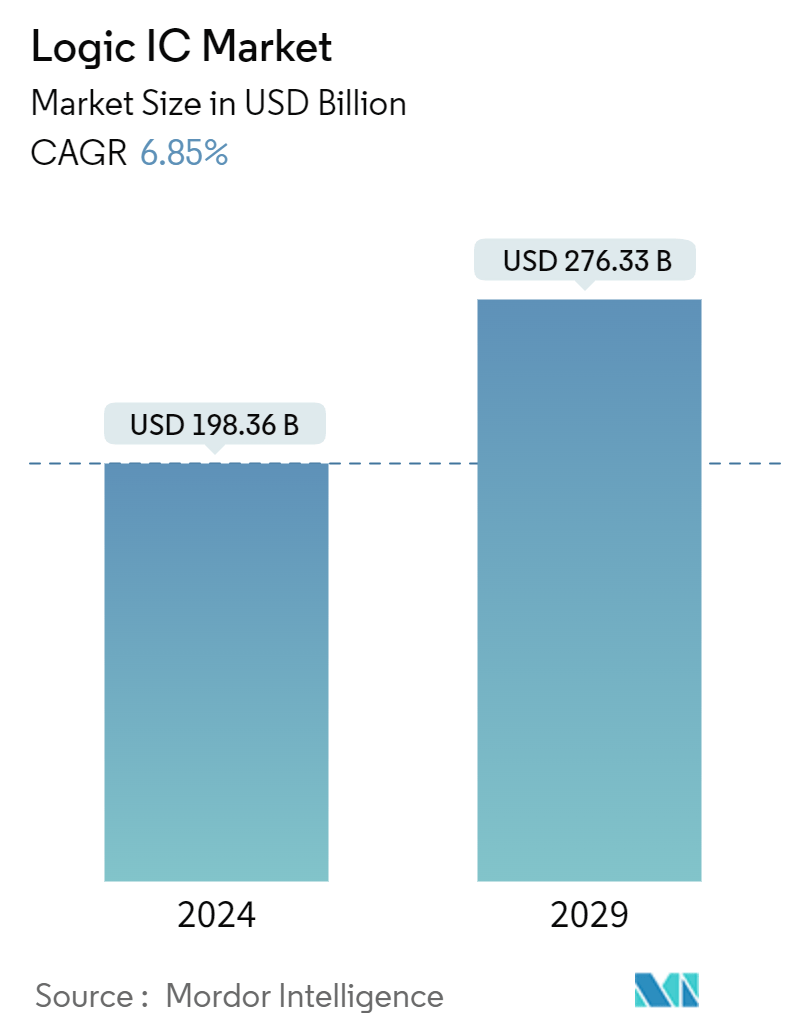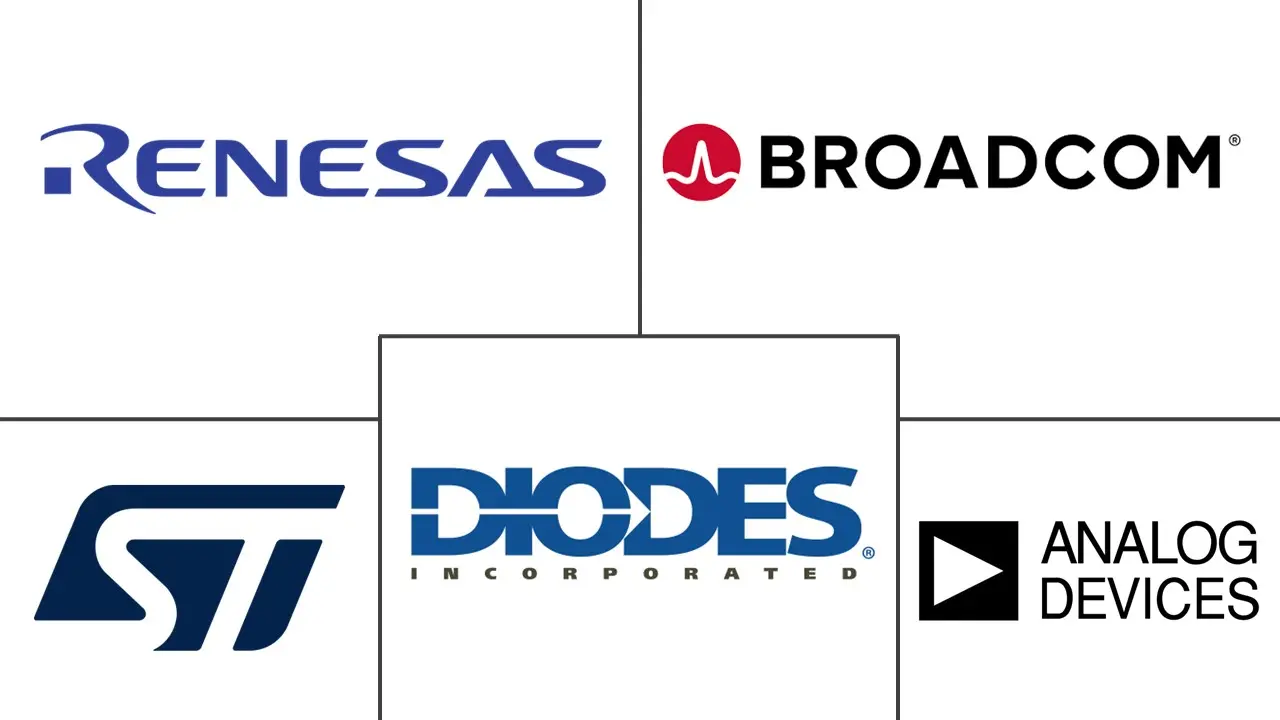Market Size of Logic IC Industry

| Study Period | 2019 - 2029 |
| Market Size (2024) | USD 198.36 Billion |
| Market Size (2029) | USD 276.33 Billion |
| CAGR (2024 - 2029) | 6.85 % |
| Fastest Growing Market | Asia Pacific |
| Largest Market | Asia Pacific |
Major Players
*Disclaimer: Major Players sorted in no particular order |
Logic IC Market Analysis
The Logic IC Market size is estimated at USD 198.36 billion in 2024, and is expected to reach USD 276.33 billion by 2029, growing at a CAGR of 6.85% during the forecast period (2024-2029). In terms of shipment volume, the market is expected to grow from 65.24 billion units in 2024 to 80.10 billion units by 2029, at a CAGR of 4.19% during the forecast period (2024-2029).
Ongoing advancements in semiconductor manufacturing processes have led to the development of more complex and efficient logic ICs. Smaller transistor sizes, improved performance, and lower power consumption enable the creation of high-performance logic ICs for a wide range of applications. A logic IC is very flexible and can be used in various applications. One can configure them to perform multiple logical functions, such as AND, OR, NOT, and XOR. This flexibility allows for designing and developing intelligent circuits that meet requirements in different industries, such as consumer electronics, automotive, telecommunications, and industry automation.
- Logic ICs have significantly aided the miniaturization and integration of electronic devices. The development of the technology to manufacture semiconductors has produced small, more complex logic circuits on a single chip in recent years. This integration increases functionality while reducing electronic systems' physical size and energy consumption so that they can be used in portable devices, wireless technology, or space-constrained applications. Display drivers, general purpose logic, and MOS touch screen controllers are some of the logic components that have gained significant market traction in recent years.
- Furthermore, advances in end-user industries have created the need for small and robust semiconductor devices. For instance, nowadays, smartphones require a smaller PCB board, unlike traditional PCB boards. There has also been the advent of IoT devices, such as wearables with irregular and different shapes, which can only be achieved through miniaturization. This is expected to boost the need for miniaturized IC components significantly.
- The advent of the IoT and IIoT has largely impacted the design and size of electronics, with the introduction of technologies like smart homes, offices, wearables, remote monitoring, and control. Moreover, OEMs and designers consider miniaturization a primary focus while creating wearable technologies.
- Another advancement that demands miniaturized electronic components is portable electronic equipment, which requires smaller and thinner semiconductor systems for saving space and miniaturization. Due to highly integrated, high-speed applications like aerospace and electric vehicles, the demand for improved electrical performance to minimize noise effects is also evident. As a result of these considerations when designing end products, logic IC components are becoming increasingly important in developing advanced electronic systems.
- Logic ICs are expected to perform a wide range of complex functions. The demand for more state-of-the-art features and capabilities in electronic devices grows as technology advances. Designers need to incorporate complex logic circuits and algorithms to meet these requirements. This increased functionality leads to larger and more intricate designs, making it challenging to manage and optimize the complex interactions between different components.
- The market has undergone substantial changes due to the COVID-19 pandemic, impacting customer behavior, business revenues, and various aspects of corporate operations. The pandemic revealed previously unnoticed risks on the supply side, potentially resulting in shortages of essential parts and components. Consequently, semiconductor companies are proactively restructuring their supply chains to enhance resilience, and these adjustments may persist in the post-pandemic era.
Logic IC Industry Segmentation
The market is defined by the revenue generated from the sale of logic-integrated circuits offered by different market players for a diverse range of end-user applications. The market trends are evaluated by analyzing the investments made in product innovation, diversification, and expansion. Furthermore, the advancements in consumer electronics, automotive, IT, communication, and other industries are crucial in determining the growth of the market studied.
The logic IC market is segmented by IC type (digital bipolar, MOS logic [MOS general purpose, MOS gate arrays, MOS drivers/controllers, MOS standard cells, MOS special purpose]), by application (consumer electronics, automotive, IT and communication, computer, other applications), by geography (Americas, Europe, Asia-Pacific [China, Japan], Rest of Asia-Pacific and the World). The report offers market forecasts and size in volume (units) and value (USD) for all the above segments.
| By IC Type | |||||||
| Digital Bipolar | |||||||
|
| By Application | |
| Consumer Electronics | |
| Automotive | |
| IT and Communication | |
| Computer | |
| Other Applications |
| By Geography*** | |
| Americas | |
| Europe | |
| Asia | |
| Australia and New Zealand | |
| Middle East and Africa |
Logic IC Market Size Summary
The logic IC market is poised for significant growth, driven by advancements in semiconductor manufacturing and the increasing demand for miniaturized and efficient electronic components. These integrated circuits are crucial in various applications, including consumer electronics, automotive, telecommunications, and industrial automation, due to their flexibility and ability to perform multiple logical functions. The ongoing trend towards miniaturization, fueled by the rise of IoT devices and portable electronics, is further propelling the market. As electronic devices become more compact and require higher performance, the demand for logic ICs that offer improved electrical performance and reduced power consumption is expected to rise. This trend is particularly evident in the automotive industry, where logic ICs play a vital role in advanced driver assistance systems (ADAS), autonomous driving, and electric vehicle (EV) technologies, necessitating high-performance and reliable components.
The Asia-Pacific region, especially China and Japan, is a key player in the logic IC market, benefiting from strong manufacturing capabilities and a burgeoning consumer electronics and automotive market. The region's dominance in semiconductor production and assembly, coupled with the rapid growth of EVs and smart driving technologies, is expected to significantly impact the logic IC market. Major industry players, including STMicroelectronics, Renesas Electronics, and Analog Devices, are actively engaging in strategic partnerships and expansions to enhance their market presence and product offerings. These developments, alongside the increasing integration of advanced technologies in vehicles and the shift towards renewable energy sources, underscore the critical role of logic ICs in the evolving landscape of electronic systems.
Logic IC Market Size - Table of Contents
-
1. MARKET INSIGHTS
-
1.1 Market Overview
-
1.2 Industry Value Chain/Supply Chain Analysis
-
1.3 Industry Attractiveness - Porter's Five Forces Analysis
-
1.3.1 Bargaining Power of Suppliers
-
1.3.2 Bargaining Power of Buyers
-
1.3.3 Threat of New Entrants
-
1.3.4 Intensity of Competitive Rivalry
-
1.3.5 Threat of Substitutes
-
-
1.4 Analysis of Macroeconomic Trends on the Market
-
1.5 Technology Snapshot
-
-
2. MARKET SEGMENTATION
-
2.1 By IC Type
-
2.1.1 Digital Bipolar
-
2.1.2 By MOS Logic
-
2.1.2.1 MOS General Purpose
-
2.1.2.2 MOS Gate Arrays
-
2.1.2.3 MOS Drivers/Controllers
-
2.1.2.4 MOS Standard Cells
-
2.1.2.5 MOS Special Purpose
-
-
-
2.2 By Application
-
2.2.1 Consumer Electronics
-
2.2.2 Automotive
-
2.2.3 IT and Communication
-
2.2.4 Computer
-
2.2.5 Other Applications
-
-
2.3 By Geography***
-
2.3.1 Americas
-
2.3.2 Europe
-
2.3.3 Asia
-
2.3.4 Australia and New Zealand
-
2.3.5 Middle East and Africa
-
-
Logic IC Market Size FAQs
How big is the Logic IC Market?
The Logic IC Market size is expected to reach USD 198.36 billion in 2024 and grow at a CAGR of 6.85% to reach USD 276.33 billion by 2029.
What is the current Logic IC Market size?
In 2024, the Logic IC Market size is expected to reach USD 198.36 billion.

